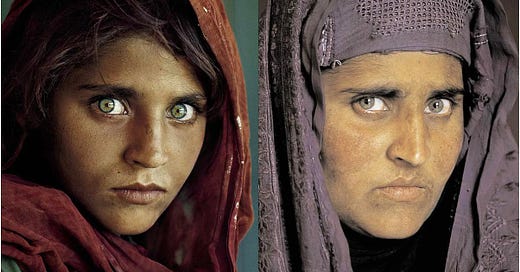Sharbat Gula: The Face You Know, The Story You Don’t
She became a symbol. But she never agreed to be one.

You know her face.
Sharbat Gula’s eyes stared out from the cover of National Geographic in June 1985. Piercing green. Tense, alert, unflinching. The world stopped. That photograph came to be known as Afghan Girl. It became iconic. Timeless. It was printed on posters, coffee mugs, exhibition walls. It moved hearts in faraway places. But her name didn’t move with it.
She became famous. Her life didn’t.
Sharbat Gula was born around 1972, in a rural village in eastern Afghanistan. When she was about six, Soviet helicopters bombed her home. Her family — siblings, father, and grandmother — fled on foot across the mountains to Pakistan. They settled in Nasir Bagh, a sprawling refugee camp on the Afghan-Pakistani border.
It was there, at age 12, she was photographed.
A photographer named Steve McCurry was documenting refugee life. He walked into a makeshift school in the camp. He saw her sitting in a corner. He didn’t ask her name. He didn’t speak Pashto. He simply raised his camera. Sharbat was a shy child. She didn’t like being photographed. But in that moment, she had little choice. One image from that roll of film would come to define her life.
And yet for 17 years, she didn’t know.
She didn’t know her eyes had stared at millions of strangers. That she had become a symbol of war, displacement, resilience. That people all over the world had seen her face, discussed it, interpreted it. All while she lived in obscurity, poverty, and struggle.
In Afghan culture, women do not show their faces to outsiders. When she learned what had happened, she was devastated. "That photo created a lot of problems for me," she later said. "I would have preferred it had never been taken."
In 2002, National Geographic found her again. A team went searching, following leads, speaking to people who remembered her. A camp resident led them to her brother. Finally, they found her. Her identity was confirmed using iris recognition software. She had returned to Afghanistan, married, had children. Her husband died in 2012. She continued to live in hardship.
Fourteen years later, she was arrested in Pakistan for using forged documents to remain in the country — a desperate, common act among displaced people. But Sharbat was a symbol, and symbols are easy to exploit. She was paraded on television. Punished. Then deported.
"I didn't like media and taking photos from childhood," she said. "But when I found out that I have been the cause of support for many refugees, then I became happy."
And yet, her struggle didn’t end. In 2021, as the Taliban returned to power, she fled again. This time to Italy, with the help of the Italian government.
Sharbat Gula is not a photo. She is not a symbol.
She is a woman who survived.
She crossed mountains at six. Lived in camps for years. Endured loss, exile, and humiliation. Raised children through war and widowhood. Wore her burqa with quiet dignity. Was turned into a global face of suffering without her consent.
Her story is not extraordinary because of that cover.
It’s extraordinary because it is so painfully common.
A refugee girl. A forgotten woman. A face the world used, but never truly knew.




Amazing story of resilience. I was 9 years old when this magazine was delivered by post. Parents had been lifetime subscribers. Because of National Geographic sentiment regarding wars and refugees, my family adopted 4 kids from war torn countries. Thanks for telling her story. I will recognize this face anywhere, and now i know her story, thanks to you. Bless you for that. May peace and prosperity find Sharbat Gula and her family.
I do - I remember just like I remember the naked child Vietnam that made headlines as she was burning. So where are the global protestors now?